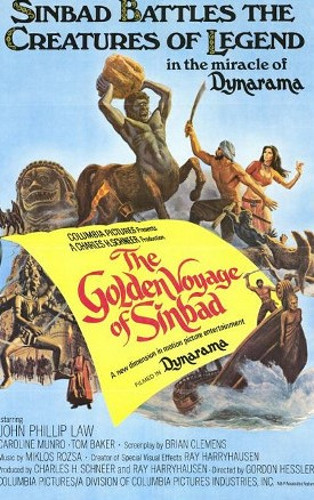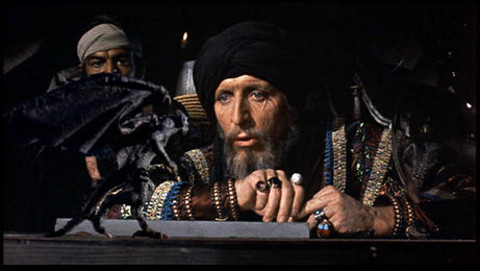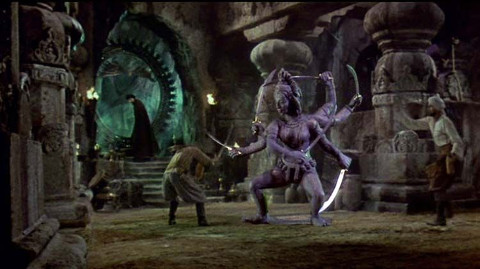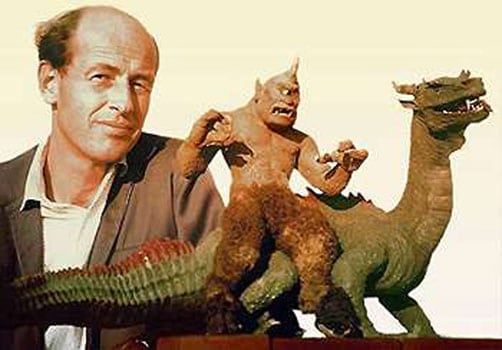The Golden Voyage Of Sinbad (1973)
Directed by: Gordon Hessler
Written by: Brian Clemens, Ray Harryhausen
Starring: Caroline Munro, Douglas Wilmer, John Phillip Law, Tom Baker
USA
AVAILABLE ON BLU-RAY AND DVD
RUNNING TIME: 105 mins
REVIEWED BY: Dr Lenera, Official HCF Critic
While sailing, Sinbad obtains an amulet carried by a small winged creature belonging to aan evil magician named Koura, and has a strange dream which includes a mysterious girl with an eye tattooed on her right palm. A storm throws his ship off course, and Sinbad and his men find themselves in the country of Marabia. The Grand Vizier says that Sinbad’s amulet is actually one piece of a puzzle; the Vizier has another. The three pieces, when joined together, will reveal a map showing the way to the Fountain of Destiny, hidden somewhere on the lost continent of Lemuria. He who bears the three pieces of the puzzle to the fountain will receive youth, a shield of darkness, and a crown of untold riches. Sinbad sets sail, taking with him the Vizier and a slave girl called Margiana, the girl he saw in his dream- but Koura is also heading that way….
Which is the best of the three Harryhausen/Schneer Sinbads? I would imagine that The 7th Voyage Of Sinbad would be top in most people’s affections, followed by The Golden Voyage Of Sinbad, though the latter is possibly gaining in popularity of late, which kind of mirrors how I’ve felt about it over the years. Its slower pace and more sober tone meant that it used to be a most distinct ‘second’ in my view for a great many years, but my more recent watchings of the film, and especially my one of the Blu-ray a few days ago, have increasingly picked up on its qualities, and no longer will I wonder why some people prefer it. In some respects, I’ll even now admit that it’s better. It has a more authentic Middle Eastern atmosphere, better dialogue, and it ties with Jason And The Argonauts as representing both the artistic and the technical peak of Harryhausen’s Dynamation effects. It isn’t quite as much fun as 7th Voyage Of Sinbad to me though, lacking some of its childlike sense of wonder, and suffers a little by not having any really ‘large’ creatures. It’s all down to taste though; The Golden Voyage Of Sinbad is certainly more mature, even adult, in tone, and I’ll happily watch films both every two or three years. With this particular sequel [though is it technically a sequel, seeing as it doesn’t follow on from the earlier movie at all?], they really did it right, succeeding in making a picture which had a very different feel to the predecessor yet still retained its basic plot elements and was clearly from some of the same creators.
Harryhausen first thought of doing a second Sinbad film in 1964 just after Jason And The Argonauts, when he made some sketches of some random ideas he had; a giant guarding the lost city of Petra, the six-headed Indian goddess Kali, a centaur [half-man, half-horse], an oracle, and a magician creating a Homunculus [tiny winged creature man-made creature]. After several treatments it was Brian Clemens, best known for The Avengers, who wrote the final screenplay, though for a while Harryhausen also considered a project entitled King Of The Geniis which would feature Sinbad and dinosaurs! How amazing does that sound? Sadly the commercial failure of The Valley Of Gwangi put paid to that idea, so after a break it was back to the Arabian Nights, and a few variations on things seem in the 1940 version of The Thief Of Bagdad. At least two major sequences were dropped; a valley of giant snakes because snakes terrified Schneer, and a rather scary-sounding pre-credits scene showing how the Vizier, who later shows up wearing a mask, was disfigured, shot from the low point of view of the Humunculus, who creeps up on him while he’s asleep and pours burning liquid onto his face. Other ideas, like a man being turned into a baboon, a Troglodyte and a giant stone face, later made their way into the third Sinbad film. Said Troglodyte was originally going to battle the Cyclops/Centaur. Orson Welles was initially cast as The Oracle, but his agent asked for an extremely high fee for the expected three days of voice work. Robert Shaw, who was on vacation in Spain, did the work in one day Though plans to film in India failed to work out and production had to relocate to Spain [chiefly Madrid and Majorca] which was where The 7th Voyage Of Sinbad was filmed, the film came in under budget. Released at a time where family flicks were thin on the ground, the film was a huge hit, The 7th Voyage Of Sinbad was profitably re-released, and Sinbad And The Eye Of The Tiger put into production very quickly.
The 7th Voyage Of Sinbad begins with a big action scene involving Sokurah the magician, a Cyclops and a Genie. The Golden Voyage Of Sinbad, by contrast, opens in a more low-key fashion with the brief encounter with the Humunculus, and it always makes me chuckle how, if that rash member of Sinbad’s crew hadn’t fired an arrow at the creature causing it to drop that amulet onto the ship, then all subsequent trouble would have been avoided. Sinbad’s dream is surprisingly dark in tone but lets us know that this film will be different. Much of the action in it takes place either at night or underground, and there’s a stronger sense of the uncanny, taking things closer to the horror movie in places even though interestingly there’s less brutality than in the other film. The first half of The Golden Voyage Of Sinbad is a little slow, with the exposition becoming a tad heavy; as a kid it took me three viewings to totally understand all this amulet stuff Sinbad and the Vizier are talking about, while I’m still not a big fan of stories that include prophesies that tell you things that you later see happening. One can imagine young kids shifting in their seats waiting impatiently for the good bits! Still, the writing is often quite sharp, with the many references to Allah really helping to give the impression one is in a Moslem world, and the script even incorporates an Islamic saying; “trust in Allah – but tie up your camel”. Even some sly references for the adults are snuck in: a mention of somebody’s liking for the hashish, somebody else mentioning their preference for large women even though “at night a cotton seed is a pearl”, Morgiana’s question to Sinbad; “are you sleeping in there tonight”, the implication being that, her being a slave, she’s expecting her new master to take the usual liberties a man would take with a pretty female slave. Her former master gives her to Sinbad so he’ll take his lazy son Haroun with him on his voyage. It’s funny when Haroun awakes, horrified, on the traveling ship, but later rather cool when he shows surprising mettle when facing perils – in fact he’s basically responsible for dispatching not one but two creatures.
So both Sinbad and Koura are racing to Lemuria, Sinbad wanting to get there first because, if Koura reaches the Fountain of Destiny first, the powers that the Fountain will give him will enable him to rule the kingdom Marabia which he’s already been terrifying. Along for the ride are Morgiana and The Vizier who wears a mask because his face was disfigured by Koura. Originally there was to be no major set piece on Sinbad’s ship, but fortunately they decided to add one at the last moment and it’s good that they did, otherwise it would have been over an hour before any creatures bigger than the Humunculus arrived. The ship’s figurehead breaking free and attacking the crew, which begins in amusing fashion with a drunken Haroun seeing the statue move, is a tremendously exciting and vivid set piece with a touch of terror, and the scene after of Koura resurrecting his dead Humunculus, which in close-up looks very much like Harryhausen’s Ymir from 20 Million Miles To Earth but with wings, is fascinating and eerie. The tiny monster’s struggle into subservient life actually creates a bit of sympathy for it, with it even letting out an agonised yell as it’s brought to life, as if he’s in pain and just wants to be left dead. I can’t help but think of Frankenstein’s Monster whenever I watch this scene. Sinbad and co. arrive in Marabia and have a rather pointless encounter with The Oracle of All Knowledge, but never mind, the final third delivers the thrills you’ve been promised at a non-stop pace. The high point is the incredible battle with the six-armed Kali, a truly remarkable sequence which for me is on a par with Jason And The Argonaut’s skeleton battle. The animation is incredible, the choreography is first class, co-ordination is perfect. Classic cinema fantasy action that never dates. All the creatures in this film are integrated better into the backgrounds then in every other Harryhusen film, even if the darker surroundings undoubtedly helped here. The Kali sequence is then followed by a duel between a Gyphon and a thing which is half-Cyclops and half-Centaur, and a sword fight where Koura is invisible., though Koura would have been even harder to defeat if he hadn’t been wielding a [visible] sword.
Despite the underground setting of all this, the caves are often lit in vivid colours [especially green] straight out of a Mario Bava film, while there’s a greater variety of special effects techniques employed including far more matte paintings to depict Lemuria, which in contrast to Colossa is green and full of vegetation. The plot, constructed as a series of puzzles, is reasonable enough even though I can never figure out why exactly the Gryphon and the Cyclops Centaur are fighting [because we have to have a monster fight, that’s why!], and why Morgiana was tattooed with that eye on her arm – in fact her whole background is vague and she probably wouldn’t be as scantily-clad in a Moslem environment as she is all the time in this movie. Lemuria actually was a legendary continent that may have existed millions of years ago, though the cultural hodgepodge from Cambodian statues to Kali from India to one native wearing a Shinto ritual mask to even Stonehenge is a tad lazy, and Sinbad does seem to get to this supposedly hard-to-find place far too easily. But most of the cast make okay attempts at Middle Eastern accents, and John Phillip Law does fairly well as a slightly less competent Sinbad, though all Caroline Munro seems to have asked to do is stand there and to look sexy. Early TV and video showings contained a shot where an errant breast pops out, but unfortunately for the DVD and subsequent Bu-ray release they digitally modified the shot by adding longer hair. How could they? However, you can still see Munro being accidentally poked in the privates by Law’s sword, her reaction in plain view. Tom Baker, whose performance in this led to his casting as the best Doctor Who ever, is superbly malevolent as Koura, yet is allowed some vulnerability by each of his magic acts resulting in an area of his body aging. When he reaches the Fountain of Destiny and desperately tries to crawl to the water that he knows will bring back his youth, we feel a a surprising pity,especially considering that he wants things that we would want – he just has no scruples about how he gets them.
Director Gordon Hessler [yes, these films did have actual directors even though Harryhausen is generally considered to be the auteur of them] seems more engaged in some scenes than others, though overall does a decent job. Rozsa’s score is every bit as good as Herrmann’s for The 7th Voyage Of Sinbad; his orchestration is slightly less inventive but the music is more melodic and maybe more appropriate for the settings. Sinbad’s theme and Koura’s theme do battle throughout, and there’s a tremendous phantasmagoric Indian dance like piece for the Kali battle. Sadly the score was mucked around with in places, sometimes replacing music with other music taken from earlier cues. But on the whole The Golden Voyage Of Sinbad, while it still doesn’t quite match The 7th Voyage Of Sinbad for me, is a follow-up made with care and thought, and another classic fantasy adventure from Schneer and Harryhausen. And it’s the only one out of the three that depicts its hero the way I like him best; as the sailor who prefers the freedom of the sea, rather than the semi-nobleman who’s attempting to marry into royalty and thereby put a stop to his adventuring.










Be the first to comment